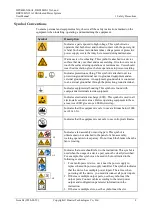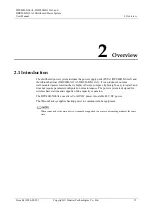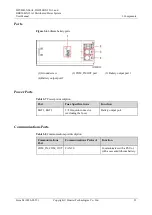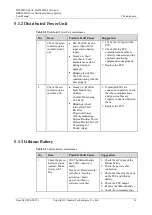
DPU40D-N06A3, DBU20B-N12A3, and
DBU50B-N12A1 Distributed Power System
User Manual
2 Overview
Issue 04 (2020-02-29)
Copyright © Huawei Technologies Co., Ltd.
17
−
PSU plus RRU
Easy to operate
−
Can be installed by one person
−
Same set of mounting kits for all scenarios, survey-free
−
Quick connectors for input and output ports and communications ports, which are
foolproof and prevents reverse connection
−
Plug-and-use, no need to set parameters or communications addresses
Easy to expand
−
PSU: online expansion to increase loading capacity
−
Lithium battery: online expansion to increase backup time
Easy to maintain
−
Remote monitoring
2.3 System Configuration
Table 2-1
Typical system capacity specifications (DPU40D-N06A3)
Number of
Load Routes
Number of
PSUs (PCS)
Number of
Lithium
Batteries
(PCS)
Power
Backup
Capacity (Wh)
(DBU20B)
Power
Backup
Capacity (Wh)
(DBU50B)
3
1
0
0
0
6
2
0
0
0
3
1
1
960
2400
3
1
2
1920
4800
3
1
3
2880
7200
6
2
1
960
2400
6
2
2
1920
4800
6
2
3
2880
7200
12
4
4
3840
9600
PSU (DPU40D-N06A3):
−
When one PSU is configured, the maximum output power of the PSU is 2000 W.
−
When two PSUs are configured, the maximum output power of the PSUs is 3800
W.
−
When three or four PSUs are configured, the maximum output power of the PSUs is
2000 W x number of PSUs x 0.8.
Lithium battery (DBU20B-N12A3):
















































